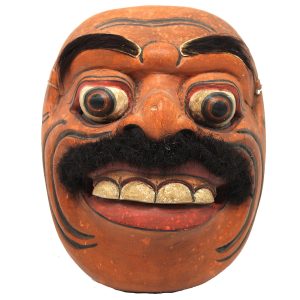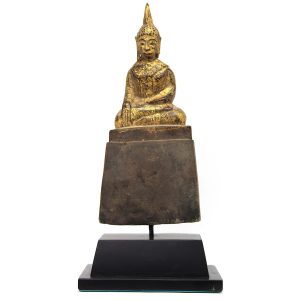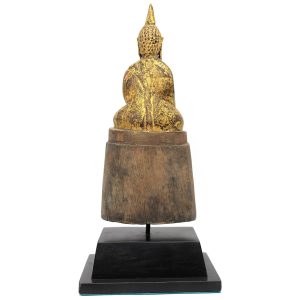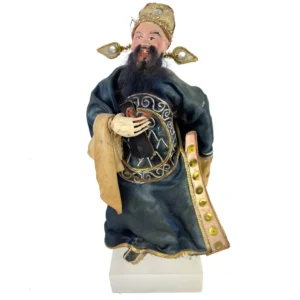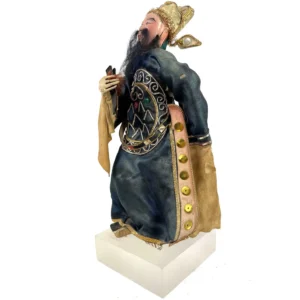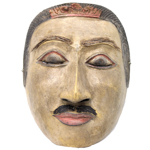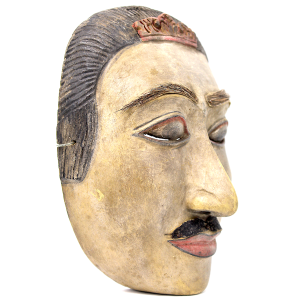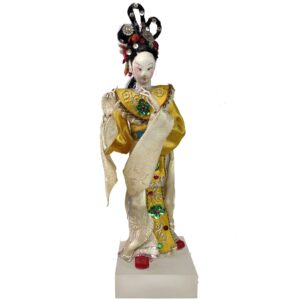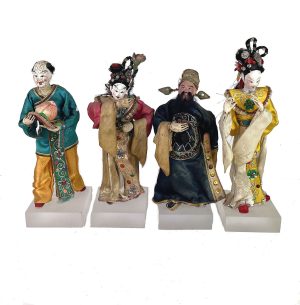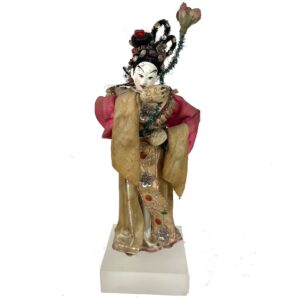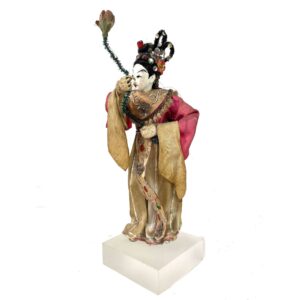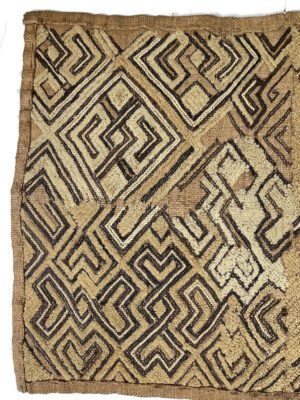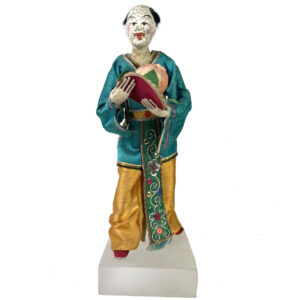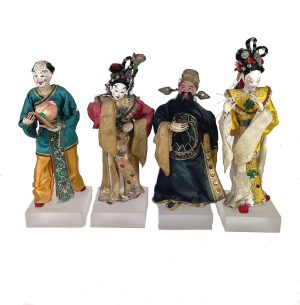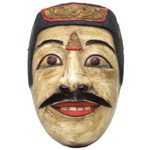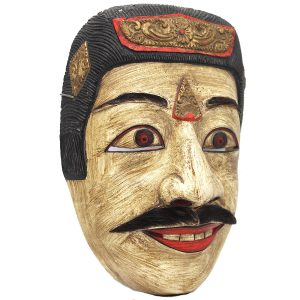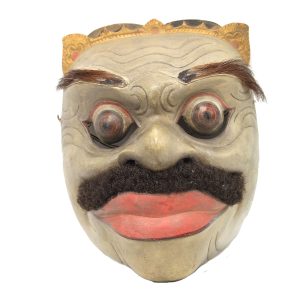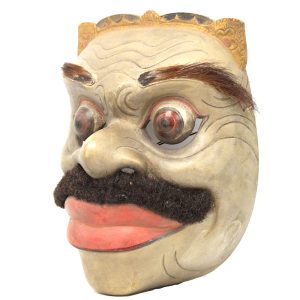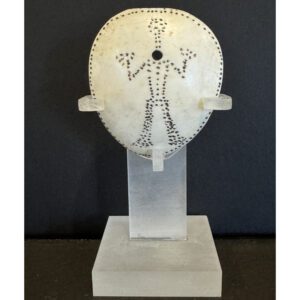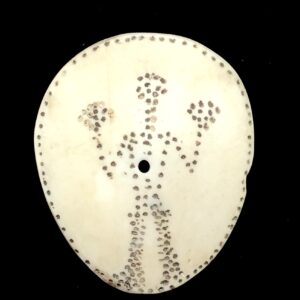Showing 73–84 of 89 results
-
Sale!


$110.00 Original price was: $110.00.$0.00Current price is: $0.00.
H: 7.625″ W: 6.125″ D: 3.375″ | FREE SHIPPING within continental u.s.
Most jauk keras (strong, scary) masks of a giant are often red or orange to reinforce a volatile dance with jerky movements. This jauk manis (good, sweet) mask dance is a more controlled, regulated and enacted with more calm and human movements.
-


$295.00
H: 9” W: 4.25 D: 3.125” | FREE SHIPPING
This mid 20th century Buddha Shakyamuni in Earth Witnessing position is carved in rural Lao style. Covered with gilt, the small rustic and simply carved image follows Lao artistic canons for depicting a Buddha: a curved hairline and high arched eyebrows that meet at the bridge of the nose, distinct hair curls, long ears, and a flame-shaped radiance emerging from his ushnisha. Its very large base is as tall and wide as the image, reflecting Laotian beliefs that a high pedestal reflects a deep respect for the Buddha. A base has been added for display purposes. Authentic old Lao images, even small personal ones like this, are difficult to find.
-
Sale!


$195.00 Original price was: $195.00.$135.00Current price is: $135.00.
Ht: 8.75″ D: 4″ D: 3.125″ | FREE SHIPPING within Continental U.S.
Colorful bearded official/entertainer doll with traditional hat, dark blue and gold robe holding paper clappers castanets. Mounted on lucite.
-


$105.00
This Dalem is a traditional folk-art and ethnic mask (topeng) from Bali made from pulai wood of a Hindu king (Dalem). He stares directly at the viewer while his high cheeks help express his poise and the ability to remain cool in a crisis. This is a fine example of a gifted carver able to…
-
Sale!


$195.00 Original price was: $195.00.$135.00Current price is: $135.00.
H: 10.5 ” W: 3.5 ” D: 3.125″ | FREE SHIPPING WITHIN CONTINENTAL U.S.
Charming Chinese Nuo Opera dancer wearing a costume with 5-petal plum blossoms symbolizing a wish for the Five Happinesses: prosperity, long life, health, a virtuous life and natural death.
-
Sale!


$195.00 Original price was: $195.00.$135.00Current price is: $135.00.
H: 8.75 ” W: 4 ” D:3.125 ” | FREE SHIPPING WITHIN CONTINENTAL U.S.
Chinese opera dancer doll with elaborate headdress and 5-petal plum blossom on sash symbolizing the Five Happinesses: prosperity, long life, health, living a virtuous life and dying a natural death.
-
Sale!


$95.00 Original price was: $95.00.$75.00Current price is: $75.00.
H: 18″ W: 18″ | FREE SHIPPING WITHIN CONTINENTAL US
Woven from strands of raffia palm leaves, this traditional vintage bordered square Kuba cloth from the Democratic Republic of the Congo was made using vegetable dye and is embellished with sophisticated embroidered, applique and patchwork linear designs.
-
Sale!


$95.00 Original price was: $95.00.$75.00Current price is: $75.00.
H: 18″ W: 18″ | FREE SHIPPING IN CONTINENTAL US!
Woven from strands of raffia palm leaves, this traditional vintage bordered square Kuba cloth from the Democratic Republic of the Congo was made using vegetable dye and is embellished with sophisticated embroidered, applique and patchwork linear designs.
-
Sale!


$195.00 Original price was: $195.00.$135.00Current price is: $135.00.
H: 9.25″ W: 3.125″ D: 3″ | Free SHipping within continental u.s.
Vivacious attendant doll offering huge peach in vibrant Chinese dance costume in red, yellow, green-blue with sequins, silver and gold thread and plum blossoms as wish for Five Happinesses. On Lucite stand, part of set of 4 .
-


$105.00
All ethnic mask (topeng) dances in Bali are accompanied with music from a gamelan percussion orchestra as are dramas and other entertainments considered as offerings to honor, please and attract the favor of the gods and ancestral spirits. In the west dancers put on masks to pretend they are someone else. Balinese dancers become the…
-


$125.00
Court ministers (patih) in Bali, Indonesia are danced in mask (topeng) performances named Topeng Panjegan where a single dancer interprets 5 legendary characters wearing full face masks, cannot speak and much portray them only through gestures and body language and positions. Patih manis (literally sweet, a good natured, diplomatic minister) is often the first solo…
-
Sale!


$295.00 Original price was: $295.00.$260.00Current price is: $260.00.
H: 4.6″ W:2.5 ” D: 2.12 ” | FREE SHIPPING WITHIN CONTINENTAL U.S.
Made by the Naga, tribal ethnic groups in India, conch shell ear covers were worn by warriors attached to pierced ears through a hole in the shell. Stippled abstract images of standing male with raised arms as status sign, mounted on Lucite base and is a fascinating piece of cultural art.
End of content
End of content

